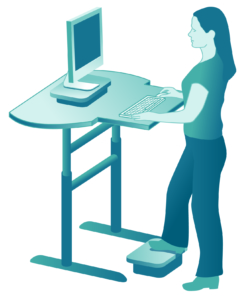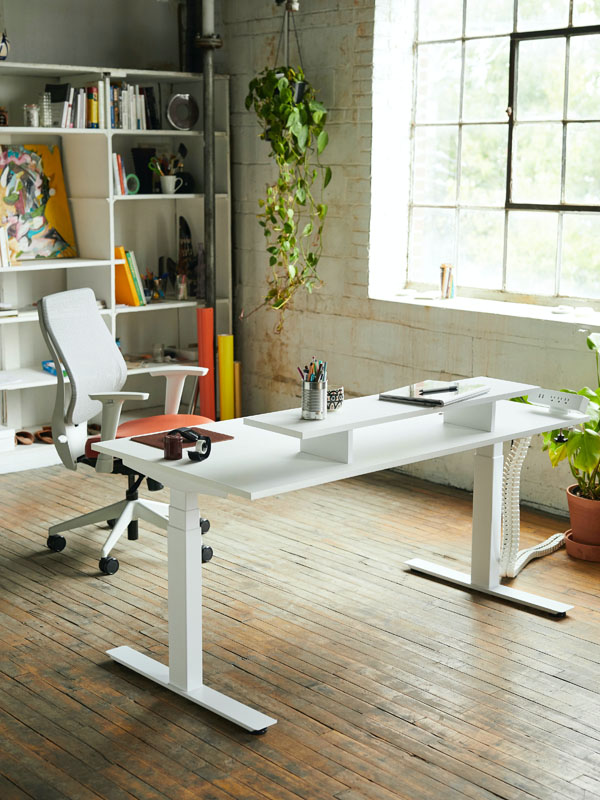
- Jan 09, 2018 |
- Ergonomics Blog, Posture, Sit to Stand Options
Practical Tips for Using a Sit-Stand Desk
Practical Tips for Using Your Sit-Stand Desk

Research has proven that introducing sit-stand workstations in the office can reduce workers sitting time and make them less sedentary and less susceptible to injuries and other disorders, at least in the short term. But the use of these desks seems to be very dependent on the amount of up-front training, reminders to use, and general “nagging” to get most people to use them. The evidence suggests that effective training and ongoing support is necessary to get people to reduce their sedentary behaviours. And it has been my experience, in helping people to set up their “new” sit-stand desk, that many people don’t feel comfortable and are even a bit ‘afraid’ using them at first and need a bit of help to understand how, when, and why to use them.
Your body was meant to move. It is not comfortable sitting for extended periods of time at a desk and if your chair and desk are not set up well, you can start to feel stiff muscles in your neck, shoulders, upper and lower back and even hips and legs. Sometimes people feel pain in their wrists, elbows, and forearms due to improper desk set up. Proper ergonomic set-up can help you ensure you will be comfortable. So, if you are lucky enough to have a sit-stand desk, here are some tips on how to set it up and use it to make you most comfortable.

SIT STAND WORKSTATION SET-UP TIPS
NEUTRAL POSITION:
The first thing to remember is that your body is most comfortable in a position called the “neutral position”, which is like standing. If you think about what your body does in this position, your head faces forward with your chin level, your shoulders are relaxed, your elbows hang close to your body, and you have an inward curve in your lower back. It’s best to set up your computer to enable your body to maintain that position. So, when you relax your shoulders and have your elbows close, bend your elbows to 90-degrees and your keyboard and mouse should fall just below your fingers. Too high and your shoulders will shrug. Too low and you bend your wrist backwards to use your keyboard or your mouse. Once you have this position determined, SAVE IT to your desk program if that’s available to you.
MONITOR HEIGHT:
Now, set your monitor height so that when you look straight ahead, your eyes see the top third of your screen without you having to look up or down much to see the entire screen. Too high and your eyes will widen and your chin will raise; too low and you will hunch forward to view the screen. The distance to your monitor(s) is different for everyone, but a general rule of thumb is no closer than a full arm’s length away. If you can see them further away, that is even more comfortable for your eyes. Too close and you may feel eyestrain. But don’t have them so far that you must lean forward to see them.
KEYBOARD AND MOUSE POSITION:
Make sure you keep your keyboard and mouse close to the front edge of your desk. This will ensure that you don’t reach for them. Your desk is not meant to lean on. USE YOUR CORE to keep you upright. When you are tired, sit!! If you are getting pressure on your wrists from the desk edge, it may be because you are dropping your wrists down to the surface to rest. Try not doing that and using your muscles to hold you. If you need a palmrest, this may be a solution for you but ensure you don’t get pressure on your wrists from that accessory.
SHIFTING BODY WEIGHT AND USE OF FOOTREST:
When you are standing, it’s not comfortable to stand on two feet equally for very long. Your body will want to shift weight from one leg to another. This puts stress on your pelvis, your hips and lower back. It is more comfortable to use a footrest and put one foot up on it. When tired, switch feet. This will help keep your pelvis level and enhance your standing comfort and tolerance.
HOW LONG TO STAND:
Depending on your tolerance, you may want to sit after about 20-40-minutes. If you are tired from standing and or find your muscles getting stiff or sore, this is a good time to sit down for a while.
ANTI-FATIGUE MAT?
Some people feel they need an anti-fatigue mat to “soften the blow” from standing. My belief is that you should only stand as long as your body is comfortable. At that point, if you are able, lower your desk to seated and sit properly until you are tired of sitting and then stand up again. This will eliminate the need to continuously move a mat in and out of the way, as your chair will not roll over it easily.
FOOTWEAR:
It is best to wear good supportive lower-heeled shoes when standing to work. High heels place stress on your lower back and tighten the calves and aren’t good for standing in one place for long periods.
LIFTING / LOWERING YOUR DESK:
It is important that your desk moves easily enough. You shouldn’t have to struggle to adjust it. If it is counterbalanced, ensure the tension on it is adjusted properly to avoid undue hardship. Before you try to lift it, check the wall behind your desk. Will the desk hit papers or pictures tacked onto your back board? Will the monitor hit an overhead shelf as it rises. Ensure that these things are properly dealt with so that adjusting your desk is a good experience.
FREQUENCY OF MOVEMENT:
Ergonomists say “The Next Position is the Best Position”, so it is good to move often. Ideally, once every hour, but that doesn’t mean you have to stand to work at your computer every hour. Just simply get up out of your chair. If you are new to standing at your computer, you will likely find it fatiguing and your feet, lower and upper back muscles might get sore. Try it for short periods of time at first and build up your stamina. But don’t give up. Having the option to stand up to work is an option only a select few have, and you should consider yourself very lucky!!
Enjoy your desk and the benefits associated with changing your position!!
Anderson Ergonomics offers lunch and learn and mini-style seminars to teach people how to properly use their desk (and chair). See our Training. Contact us for more details.



